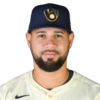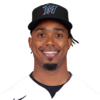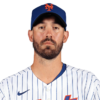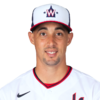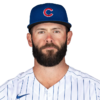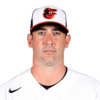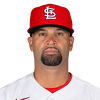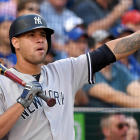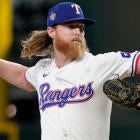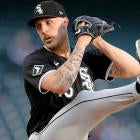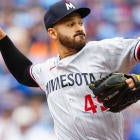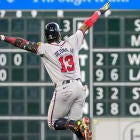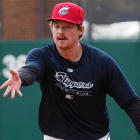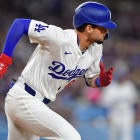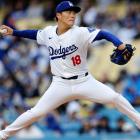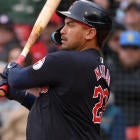In early February, I looked back at the biggest busts of the 2016 Fantasy baseball season and came up with five categories of busts who fit together. These weren’t players whose regression nobody could have seen coming. These were the guys who, with the benefit of hindsight, had some red flags we might have ignored.
Now, let’s look ahead to the 2017 season, with four players who might fit into each category of mistake, starting with one bonus category we didn’t cover the first time. We don’t have the benefit of hindsight, but we do know what type of players who busted last year, which can hopefully help identify players who might in the future.
All ADP data courtesy of FantasyPros.com.
Bonus Category: Drafted on limited track record
Last Year’s Examples: Carlos Correa, Maikel Franco, Miguel Sano
Trea Turner
Washington Nationals SS
|
| A lot of the time, we make a mistake of betting on young players improving on where they have been to return value, but Trea Turner really doesn’t have to change a thing. He hit .342 and put up 150-game paces of 20-plus homers, 60-plus steals, 100-plus runs and 80-plus RBI. If Turner did that for a full season, he’d be a steal 12 picks before his No. 14 ADP. If he’s 90 percent that good, he’s a nice value in the second round. However, we were saying a lot of the same things about Correa a year ago, and even he disappointed us last year. Turner very well may be an elite Fantasy option, but with just 100 major-league games under his belt, it’s a lot to bet on. |
Gary Sanchez
N.Y. Yankees Yankees C
|
| When talking about prospects, there are always a few unspoken clauses hanging around at the end of scouting reports, and one of them is: “He’s a pretty good hitter (for a catcher).” Such was the case for Gary Sanchez, a long-time top prospect who personified “pretty good hitter (for a catcher),” sporting a career .274/.339/.460 line in the minors, with 23 homers per-150 games. If Sanchez was a first baseman or right fielder, he probably wouldn’t have made anyone’s top-100 lists. But any first baseman would be thrilled to have the kind of introduction to the majors Sanchez did in 2016, when he hit .299/.376/.657 in 53 games. Like Turner, if Sanchez can be 90 percent as good this season as he was last, he’s an easy first-rounder. However, if he goes back to being what he was in the minors, we already know what his Fantasy outlook will be: “He’s a pretty good hitter (for a catcher.)“ |
Aledmys Diaz
St. Louis Cardinals SS
|
| Aledmys Diaz is a test case for how much scouting and minor-league production matter. Nothing about his numbers from 2016 stand out as alarming. His batting average is supported by a strong approach at the plate and solid power, which is backed up by an ability to create consistent hard contact. However, he was just a .275/.335/.441 hitter across 165 minor-league games, and was never considered a huge prospect coming up through the system. Do 111 excellent games at the majors render all minor-league and scouting expectations moot? If so, his current ADP of 140 will be too low by half. |
David Dahl
Colorado Rockies LF
|
If you can just be a competent major-league hitter, Fantasy players will love you in Coors Field. David Dahl looked more than competent in 2016, hitting .315 with a .185 ISO in 63 games as a 22-year-old, numbers that are easy to get excited about. He isn’t a can’t-miss prospect, but Dahl hit .278 with 19 homers in 149 career games at Double-A, numbers that would only get better playing half his games at Coors. However, he isn’t even guaranteed an everyday role right now, and needed a .404 BABIP to hit as well as he did. If Dahl is more like a .260 hitter, even Coors might not be enough to save him. |
Mistake Category 1: Paid for a career year
Last Year’s Examples: Bryce Harper (No. 1), Dee Gordon (No. 32), Dallas Keuchel (No. 35), Zack Greinke (No. 34), Lorenzo Cain (No. 58)
Mookie Betts
Boston Red Sox RF
|
| It seems ridiculous to suggest that a 23-year-old might have had his best season ever, but it’s not out of the question with Betts, who had seemingly everything possible go right for him in 2016. It’s not that it was a fluke, but Betts seemed to roll 7’s all season long. As great as he is, expecting a repeat of that might be asking too much. And it’s worth noting, his top comparable player on BaseballProspectus is Al Kaline, who peaked at 20, but nonetheless went on to a Hall of Fame career. There’s no shame in that, but it might make Betts a disappointment after he topped Mike Trout in 2016. |
Jean Segura
Seattle Mariners SS
|
| Everything went right for Segura, too, but his 2016 season wasn’t just a fluke. He made some real improvements. Segura more than doubled his walk rate, and posted a career-best .181 ISO, buoyed by a career-high 29.7 percent hard-hit rate. However, this was a huge outlier from his career, and the move to Seattle in the offseason gives him a much less forgiving offensive environment than Arizona. I’ll have trouble drafting him at his fifth-round ADP. |
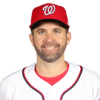
Brian Dozier
Minnesota Twins 2B
|
| Dozier’s power spike didn’t come about as a result of him becoming more pull-happy, or more of a flyball hitter. He didn’t necessarily sell out for power, in other words. He just hit the ball consistently harder, bumping his hard-hit rate from 29.2 to 34.7 percent, and his average batted-ball velocity on flyballs and line drives jumped from 92.5 MPH to 94.4. Dozier’s career year will be hard to match, however, and it’s tough to bet on him having reached a new level of performance at 30. |
Freddie Freeman
Atlanta Braves 1B
|
| As of this writing, Freddie Freeman is currently the No. 29 player and No. 7 first baseman off the board. That’s an awfully steep price to pay for a first baseman with an established track record of sub-elite production in a lineup that won’t exactly give him a ton of opportunities. Freeman isn’t bad, per se, but his improvements as a power hitter in 2016 came with reduced contact, and even as a high-BABIP player, he’s probably more like a .270 hitter with no guarantee of 100 RBI or runs. That’s not a second-round pick at 1B. |
Mistake Category 2: Paid for pitcher with middling strikeout rates
Last Year’s Examples: Zack Greinke (No. 34), Dallas Keuchel, Sonny Gray, Michael Wacha
Rick Porcello
Boston Red Sox SP
|
| It might be hard for Rick Porcello to actually be a bust, just because every Fantasy analyst in the industry is driving his price down. Porcello took a real step forward as a pitcher in 2016, but a lot of it was based on an increase in called strikes. As a pitcher with middling stuff, he has to get by on guile, and as we saw in 2015, things can go wrong in a hurry. Even at a seventh-round value, he can be a bust if he isn’t worth a roster spot by May. |
Kyle Hendricks
Chi. Cubs Cubs SP
|
| One easy way to look for busts at pitcher is to just take FIP minus ERA and point at every single person at the top of the leaderboard. FanGraphs.com does this for us already and, well wouldn’t you know it, there’s Kyle Hendricks third from the top. That exercise is a bit pointless in Hendricks’ case, because his 3.20 FIP was still the fourth-best in the majors last season. Still, unless you’re Johnny Cueto, it’s hard to sustain an ERA around 3.00 with a strikeout rate around 20 percent, and that is what is working against Hendricks right now. An elite Cubs’ defense helps, but a fifth-round pick is too much to invest in less than seven K/9. |
Gerrit Cole
Pittsburgh Pirates SP
|
| The low strikeout rate is less concerning for Gerrit Cole than the underlying causes -- an elbow injury ended his season early, and he also struggled with a triceps strain that landed him on the DL. Cole’s velocity didn’t suffer, but he clearly wasn’t the same pitcher he was in 2015, and it’s hard to see him being an above-average pitcher again with a strikeout rate under 20 percent. Last year’s injuries could be an excuse for his struggles, but they could also be a big red flag. |
Aaron Sanchez
Toronto Blue Jays SP
|
| With his extreme groundball tendencies, strikeouts aren’t quite as necessary for Sanchez as some other pitchers. But as Dallas Keuchel showed last year, the margin for error even for a groundball artist can be slim. Sanchez’s strikeout and walk rates both moved ever so slightly in the wrong direction in the second half last season, and while fatigue could be viewed as the main cause, it’s also possible it was just the start of his limitations catching up to him. |
Mistake Category 3: Ignored signs of decline
Last Year’s Examples: Troy Tulowitzki, Yasiel Puig, Carlos Gomez
Jake Arrieta
Chi. Cubs Cubs SP
|
| Jake Arrieta is still being drafted like an elite pitcher, going off the board 23rd overall, behind just six other starters. However, his control slipped early on in 2016, and though he was able to overcome it for a while, his results just got worse as the season went on. He had a 4.05 ERA to go along with a 10.1 percent walk rate after June 1. We can’t ignore how good Arrieta was in 2015, but we also can’t hold on to it for too long. |
Andrew McCutchen
Pittsburgh Pirates RF
|
| Andrew McCutchen has already fallen to No. 61 overall in ADP, which is quite a tumble for someone who has been a perennial first-rounder. At that price, he’s actually a fine gamble, but he still needs to reverse some of the trends we saw in 2016. McCutchen’s strikeout rate ticked up, and his power took another step back, a troubling combination for a player entering his 30’s, especially when backed up by a career-high swinging strike rate and his lowest hard-hit average since 2011. Some good news: He hit .284/.381/.471 from Aug. 1 on, and even reversed his power slide in September. |
Buster Posey
San Francisco Giants C
|
| Buster Posey is still the consensus No. 1 catcher, and positional scarcity helps make it that even in a down season, he’s going to be very valuable. His 2016 was a down season, of course, as his 14 homers were his lowest ever for a full season, and Posey saw his batting average drop 30 points, too. Posey is still an artist with a bat in his hands, but one of the hazards of a life spent behind the plate is an early, and often-abrupt decline phase. The fear is, 2016 was the start of that, With Gary Sanchez’s ascension, it’s possible we’re about to see the passing of the torch at the position. |
Felix Hernandez
Seattle Mariners SP
|
| At 110 ADP, Felix Hernandez’s decline has already been priced in, which is good to see. Hernandez dropped more than a mile per hour on his fastball, and had more than half as many walks as strikeouts for the first time in his career. You might be tempted to reach on the name and potential bounceback, but it might not be a stretch to suggest we’ve seen the last of Hernandez as a useful Fantasy option. |
Mistake Category 4: Drafted on wrong side of the aging curve
Last Year’s Examples: Adrian Gonzalez, Prince Fielder
I wrote about the aging concerns with Miguel Cabrera, Ryan Braun, and Nelson Cruz last week, and all three are bust candidates for the reasons listed there. Here’s one more.
Ian Kinsler
Detroit Tigers 2B
|
| Ian Kinsler could pretty easily go in the career-year portion, so you’re starting to see a couple of concerns stacking on top of each other. During a season in which he turned 34, Kinsler saw a big uptick in power, clubbing 34 homers, his most since 2011. While he accompanied that with a career-high hard-hit average, it’s hard to buy into that being a sustainable improvement at this point in his career. Kinsler is currently going ahead of Matt Carpenter, and that’s hard to justify. |
Mistake Category 5: Ignored injury concerns
Last Year’s Examples: Adam Wainwright, Michael Brantley
Max Scherzer
Washington Nationals SP
|
| Injuries can happen to any player, and that is more true for pitchers than anyone else. Max Scherzer is usually a pretty good bet to avoid injuries, however, having made at least 30 starts in each season going back to 2009, his big-league debut. However, he suffered a stress fracture in his right ring finger in the offseason, and though he is expected to be fine for the start of spring, seemingly minor injuries have a way of turning into major ones when pitchers are concerned. |
Matt Harvey
N.Y. Mets Mets SP
|
| Of course, next to Matt Harvey, Scherzer looks like a rock. Harvey struggled through a miserable 2016 season that ended after he underwent Thoracic Outlet Syndrome surgery in July. The Mets expect Harvey to be ready for the start of the spring, but we don’t have much history of pitchers successfully returning to form after this procedure. Harvey can certainly be an ace, but even the 10th round ADP he currently carries probably doesn’t adequately take into account just how much risk he carries. The 121st pick alone probably can’t ruin your season, but getting nothing out of that pick would hurt. |
Albert Pujols
L.A. Angels Angels DH
|
| Albert Pujols isn’t just 37 years old, and he’s not just recovering from foot surgery; he’s a 37-year-old recovering from foot surgery. That is an obvious statement, but sometimes it helps to put the obvious in front of you to drive the point home. Pujols still hit 31 homers and drove in 119 runs last season, but he provided little else, with only 19 doubles and a .268 batting average. He’s a big name, one you might be drawn to when the clock starts to run down on your pick, but first base is deep enough that you should pass. |
Michael Brantley
Cleveland Indians LF
|
We already did this with Brantley last season, as he still ended up drafted in the top-100 despite offseason shoulder surgery that didn’t have him ready for the start of the season. He comes in at a much steeper discount at this point, and may still have top-10 outfielder potential, but it’s hard to say after a lost season and this kind of injury. I would love to see Brantley get back to full strength, but if positive reports in spring start driving him into the first 10 rounds, you should be very skeptical. |








